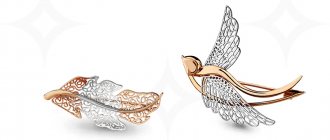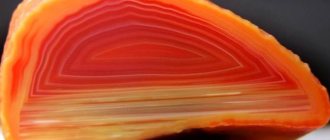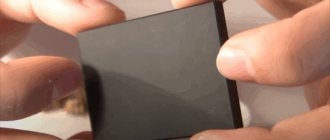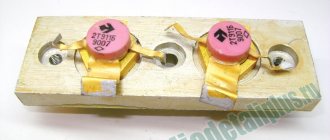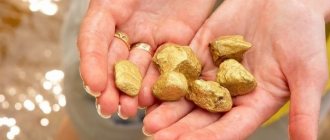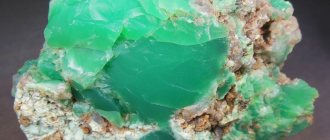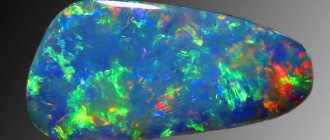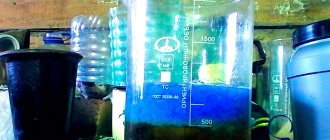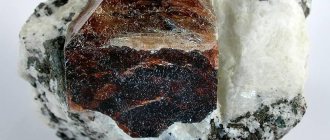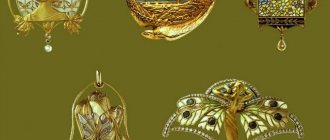| Category | Sulfides (minerals) |
| Title in English | Cinnabar |
| Formula | HgS |
| Group | Cinnabar group |
| Color | Red |
| Stroke color | Red |
| Shine | Diamond |
| Transparency | Transparent, Translucent |
| singonia | Trigonal |
| Hardness | 2 — 2,5 |
| Cleavage | Perfect |
| Density, g/cm³ | 8 — 8,2 |
| Kink | Rough, Conchoidal |
| origin of name | This mineral has a characteristic bright red color, close to the color of blood. Most mineralogists are confident that the word cinnabar has Greek roots and comes from the word κιννάβαρι. It translates as dragon's blood. However, there is an assumption that the Greeks borrowed this word from the Scythians, since they were almost 5 centuries ahead of the Greeks in the production of cinnabar. The Scythians called the paint obtained from ore kinnabis. Also, other names for cinnabar are known: blende ore and, for example, coral ore. |
The word "cinnabar" is translated from Arabic as "dragon's blood." The mineral is also known as cinnabarite. Even in ancient times, cinnabar was used as a base for making bright red paint. This method was known in Egypt and Phenicia. In Rus', icons were painted with this paint in order to reliably convey drops of blood. Under the influence of air, cinnabar oxidizes and becomes covered with an oxide film.
History of cinnabar
— Advertising —
Cinnabar has been known to mankind for a very long time. Its name, which translates as “dragon’s blood,” refers to the properties of the stone: its red color and diamond shine, and the harm to human health due to the mercury content, and the ability to transform. If a piece of cinnabar is heated, a mercury “sweat” first appears on it, and if heating is continued, the mineral simply evaporates, as if by magic.
The mythical origin of cinnabar has been attributed at all times. But already in Ancient Greece it was widely used as a red pigment. In Rome, cinnabar was considered an industrial raw material.
Today, the demand for the mineral remains high and it continues to be popular.
Place of Birth
The most widespread deposits are those formed at moderate and shallow depths. Ore bodies are confined to sandstones, shales, quartzites, limestones, and dolomites. In low-temperature hydrothermal deposits, cinnabar forms veins, solid masses, impregnations and deposits in cracks; Often cinnabar secretions are confined to silicified areas. The formation of cinnabar after quartz was noted, with the replacement of quartz and partly calcite in the latest stages of hydrothermal activity. In some deposits pcs. Oregon Idaho Nevada (USA) cinnabar accompanies opal and chalcedony in the form of submicroscopic segregations and was presumably deposited by colloidal solutions at shallow depths.
Cinnabar massive texture Altai Mountains, Chagan-Uzinskoe deposit
Less common is the presence of cinnabar in medium-temperature gold-bearing quartz veins (Ayatskoye deposit, Sverdlovsk region). In medium-temperature deposits, cinnabar is occasionally observed as a secondary mineral formed by mercury-containing fahlores; sometimes replaces hypogene metacinnabarite. The main deposits: Nikitovna (Ukraine), Khaidarkan and Chauvay (Kyrgyzstan), Chagan-Uzunskoye and Aktashskoye (Gorno-Altai Autonomous Region), Dzhizhikrut (Tajikistan). Cinnabar was also installed in the Vyshkovsky and Beregovsky districts of the Transcarpathian region. (Ukraine), along the southern slope of the Main Caucasus Range (Aheiskoe, Talakiani and Bokoe in Georgia). Deposits of global importance: Almaden (Spain), Avala (Serbia), Idria (Italy), New Idria and New Almaden (USA).
Physico-chemical characteristics of cinnabar
Cinnabar is a mercuric sulfide and one of the most common and well-known mercury-containing minerals.
It contains about 87% mercury. Cinnabar crystals are distinguished by a diamond shine or, on the contrary, a matte surface. The density of cinnabar is 8-8.2 g/cm3, the hardness on the Mohs scale is 2-2.5. Insoluble in acids, soluble only in a mixture of concentrated nitric and hydrochloric acids. — Advertising —
The size of natural cinnabar crystals reaches several centimeters. It is very fragile, fusible, and easily turns into powder.
Fire Gehenna Stone
According to its chemical composition, the mineral cinnabar is an extremely toxic mercury sulfide . This is the only ore mineral of silvery “liquid metal” in nature (there are also deposits of native mercury).
Vermilion crystal
European alchemists who inhaled the fumes of cinnabar over their hot crucibles did not live long after such experiments. This is evidenced by an eloquent fact - manuscripts with descriptions of alchemical experiments with cinnabar, as a rule, are not completed.
The mineral, cursed by Satan himself, was called the stone of fiery Gehenna. It was found in appropriate places - near active and extinct volcanoes, accompanied by the suffocating secretions of cinnabar's indispensable companion - sulfur deposits.
The magical properties of cinnabar
Cinnabar talismans are suitable for financiers, businessmen, and bankers.
They help them navigate the market, endure failures, and perceive success as a launching platform for new aspirations. At the same time, cinnabar does not allow its owner to relax, and in order to relax, the amulets with it must be removed. Cinnabar also helps the owner to enjoy every day and moment of life.
Black magicians often use cinnabar amulets to absorb negative energy.
Mercury seas of the emperor's tomb
One of the greatest wonders of ancient China is the tomb of the great emperor Shi Huangdi (3rd century BC). It was he who began the construction of the Great Wall, which is visible even from the orbit of the International Space Station.
The last refuge of the emperor turned out to be no less grandiose. His gigantic underground tomb is guarded by an army of thousands of terracotta soldiers.
Red cinnabar was also used in painting the clothes and armor of ceramic figures of warriors.
By the way, the secret weapon of the guards of the Great Wall were arrows, the tips of which were dipped in a deadly solution of cinnabar and arsenic.
According to legend, inside the tomb there is a huge hall in which a map of the lands of the Shi Huangdi empire is reproduced. The rivers and seas in this three-dimensional model are filled with tons of mercury.
Archaeologists are in no hurry to open the tomb, hidden under a man-made mountain. But it is already known that the legend is true. Soil samples contain evaporated mercury.
Medicinal properties of cinnabar
Since ancient times, the bactericidal properties of cinnabar have been known.
Powders based on it were used to treat leprosy and syphilis. But mercury could also have a negative effect on humans. Cinnabar has never found any use in official medicine. Lithotherapy advises only observing cinnabar to stimulate a person’s sexual activity, initiative and activity.
Under no circumstances should you use applications made from heated cinnabar, as this will cause mercury to evaporate from the stone.
Among the ten most dangerous
Cinnabar is one of the ten most dangerous killer minerals on Earth.
Mercury
In this dark series is galena (lead ore), which affects brain cells; asbestos , which rips apart the lungs with millions of microscopic blades of quartz crystals; gold-like arsenopyrite , containing arsenic; radioactive torburnite , filled with uranium and radon, and several other very dangerous “repeat offender” minerals.
Branches of application of cinnabar
In ancient times, red pigment was obtained from cinnabar for finishing work and painting.
Residents of Ancient Rome used this paint to decorate their houses, paint frescoes and paintings. In Rus' it was used in Khokhloma. And even old books with red headings appeared precisely thanks to cinnabar. Nowadays, cinnabar is used in industry as a source of mercury, which can be obtained by heating the mineral, and also in jewelry. However, the stone is cut relatively rarely due to its fragility and high mercury content.
But due to the fact that the mineral is plastic, beautiful openwork patterns are created on it, and carved inserts are used to decorate brooches, medallions, rings and earrings, beads and bracelets.
It is important to remember that wearing cinnabar jewelry all the time is not recommended, so as not to harm the body.
Large cinnabar clumps are also used to make beautiful interior decorations.
The inexhaustible mines of Almaden
In the mountains of the Iberian Peninsula, in Spain, there is a unique Almaden deposit. In the local mines, cinnabar has been extracted continuously for about three thousand years - since the time of Phoenician Carthage. During this time, at least half a million tons of mercury were extracted from the depths, but the mine seems to be inexhaustible.
Pliny (1st century) mentions Spanish mercury mines, describing in one of the sections of “Natural History” the properties of the mineral cinnabar and the method of extracting mercury from it.
In medieval Spain, a royal court sentence to work in the Almaden mines meant a sophisticated death. Poisonous mercury fumes caused spasms and convulsions, loss of orientation, and blindness in the miners, followed by the rapid, painful death of the doomed convicts.
It is impossible to cure a patient poisoned by cinnabar even in a modern clinic - mercury is not removed from the body by any means.
Artificial cinnabar
Already in ancient times, people learned to produce artificial cinnabar by fusing mercury and sulfur.
This method was invented in China, and gradually it spread to all continents. Thus, artists in the 15th and 16th centuries more often used artificial cinnabar rather than real one. Today, cinnabar is produced using the dry and wet method.
For the dry method, mercury is mixed with sulfur and heated in a closed vessel. First, a black powder is formed, which is sublimated and condensed to produce red synthetic cinnabar. With the wet method, mercury and sulfur are ground with water, after which alkali is added. The resulting mixture is ground until it turns red. Any of these methods is permissible only in special laboratory conditions, so as not to get poisoned by mercury salts.
Cinnabar obtained using the dry method consists of larger particles that have a bluish tint.
Artificial cinnabar is initially brighter in color, but over time it becomes gray or black and loses its quality. Natural stone can be distinguished by its uneven and conchoidal surface at the fracture.
Precautionary measures
For a long time, healers and healers around the world attributed healing properties to mercury stone, and even recommended placing it under the pillow. In China, artisans made expensive dishes from this breed. In Europe, cinnabar was used to treat syphilis (it is known that Ivan the Terrible himself underwent a similar “course of treatment”). However, few could have imagined that such treatment was more than doubtful and could lead to death. Since all mercury compounds are dangerous, cinnabar is no exception. It is the most toxic mineral to process that exists on Earth. It is no coincidence that the extraction of cinnabar ore in Spain was equated to the death penalty. Therefore, we recommend that you follow a number of rules that will help you avoid negative consequences for the body:
- Laboratory work with cinnabar should be carried out strictly according to the instructions.
- Store cinnabar jewelry in a closed box.
- Avoid heating decorations.
- Wear jewelry 1-2 times a week.
- Clean only with cool water.
Cinnabar and the zodiac sign
Cinnabar suits all zodiac signs except Scorpio. Her real favorite is Taurus. But you need to wear jewelry with this gem only in times of urgent need, so that cinnabar provides its help, but does not have time to harm. Jewelry made from synthetic cinnabar poses fewer health risks.
Satan's Apothecary
Pope Alexander VI Borgia (1492-1503) earned this gloomy nickname at the age of 25, when his uncle, Pope Calixtus III, ordained his nephew a cardinal.
This youngest prince of the Church in the history of the papacy, an aristocrat from the kingdom of Aragon named Rodrigo de Borja i Borja, was determined to transform one of the fragments of the Roman Empire - the amorphous Italian Papal States - into a theocratic state.
His dream came true. But the Pope achieved his goal not only through pious prayer. He spent a lot of time in his own alchemical laboratory. The determined pontiff often violated the commandment “Thou shalt not kill,” personally preparing sophisticated poisons for his enemies. This was an effective solution to controversial territorial and political issues. No person - no problem.
Among the poisonous components in the drugs of the Pharmacist of Satan, mercury, extracted from Spanish cinnabar, was often present.
Interesting facts about cinnabar
- The problem with using cinnabar products is that it contains a lot of mercury. As long as this metal is in a chemical bond with sulfur, it is harmless, but this bond is easily destroyed. In air, the surface of cinnabar is covered with a thin layer of metallic mercury, which either turns into an oxide or evaporates. Mercury oxide makes the stone black and unattractive, and mercury vapor enters the human body and can cause harm to it.
- In Ancient Rome, they not only actively mined cinnabar (some mines are still in operation today!), but also exported it from Spain in amounts of about 4.5 tons every year.
- In ancient times, cinnabar was an important and indispensable pigment, the source of red color for all human needs. All over the world, archaeologists are finding ancient developed deposits of cinnabar. Thus, they were discovered in the Donbass (Ukraine), Kyrgyzstan, Tajikistan and Uzbekistan. They also find ancient tools and various devices (metal wedges, lamps, clay vessels), which testify to how people lived hundreds of years ago.
Where is the mineral mined?
Cinnabar is formed in hydrothermal areas and lies shallow. It often “accompanies” other stones and serves as a marker of the close proximity of gold.
The oldest active deposits of mercury stone are Italy and the Fergana Valley.
Cinnabar
Younger sources are scattered around the world. In Europe, there is a lot of stone in Spain (cinnabar is mined here the most), Slovenia, and Montenegro. China (the best) and the USA have reserves of the mineral.
In Russia these are Yakutia, Altai, Chukotka, and the North Caucasus.
CIS countries: Ukraine, Kyrgyzstan, Tajikistan. Of the latter two, the mineral was delivered to Europe along the Great Silk Road.
How to distinguish a fake?
Artificial stone cannot be compared to the original in beauty and attractiveness: it is less bright and shiny, especially when chipped. Jewelry that is sold relatively inexpensively on the market is almost certainly a fake. Even a certificate from the seller is not always proof of authenticity: tourists in Delhi, Singapore and Jakarta have been repeatedly offered cheap analogues under the guise of the original.
A real mineral can be distinguished from a fake by the following characteristics:
- It has a rich blood red color.
- It has an alluring diamond shine.
- The stone is quite heavy.
However, in the form of a dye, artificially obtained cinnabar cannot be distinguished from the original.
Warning from the Gem Encyclopedia
Cinnabar often crystallizes into beautiful compositions. The collection samples from the mentioned Almaden deposit are especially famous.
But storing such druses in a home collection is extremely unwise . You will expose not only yourself, but also your loved ones, to the danger of incurable poisoning. Don't even try to use a cinnabar crystal as jewelry or an amulet - it will bring you nothing but misfortune.
Remember that children and pets are much more susceptible to toxic mercury than adults. It is especially dangerous to place cinnabar crystal near heat sources, including a table lamp.
It is unlikely that you will be able to make a vacuum display case using durable bulletproof glass. If somehow you happen to have a cinnabar crystal, it is better to donate it to the collection of the nearest mineralogical museum.
[Total votes: 8 Average: 3.8/5]
